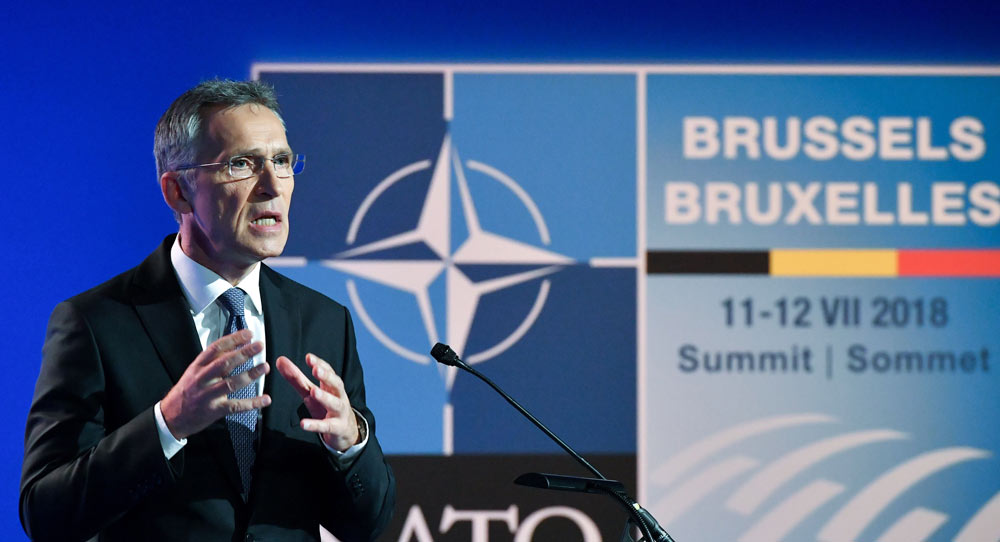Carnegie Europe is on the ground at the 2018 NATO summit in Brussels, offering readers exclusive access to the high-level discussions as they unfold.
**
For months the 2018 NATO summit promised to be a typical meeting of heads of state and government. But in recent weeks a number of announcements from Washington have caused considerable nervousness among European allies. After the June G7 summit in La Malbaie and on the eve of the planned U.S.-Russia presidential meeting in Helsinki, there has been much media hype about the potential failure of the NATO summit in Brussels. Many claim that the biggest allied success will be to maintain coherence, unity, and solidarity. This is a difficult moment in the transatlantic relationship.
Yet, for at least two reasons one should be very cautious in predicting a failure of the NATO summit.
First, this is not a unique situation in NATO history; allies have had to overcome divisions before. In 1963, U.S. President John F. Kennedy concluded during a National Security Council meeting that the United States should look at the possibility that de Gaulle would make a deal with the Russians, break up NATO, and push the United States out of Europe. Three years later, France withdrew from NATO’s integrated military command structure. In 2003, the United States—together with a coalition of the willing—launched Operation Iraqi Freedom. This led to a major disagreement between the Unites States on one side and Germany and France on the other.
Second, the secret of a good NATO summit is to discuss old things in a new way or new things in an old way. This week’s meeting will not differ. In fact, it will offer military substance, which is the true glue of the alliance. On numerous occasions, this has proven to be more important than fiery speeches and digital rhetoric.
From the political and military perspective, the summit in Brussels has three core elements to address. NATO’s burden-sharing debate should be transformed into a commitment-sharing discussion. Spending 2 percent of GDP on defense by 2024—as agreed at the 2014 NATO summit in Wales—still holds and should be implemented by all allies. But beyond cash, there are capabilities and contributions to allied operations, missions, and exercises. There needs to be more discussion on what counts as defense spending, such as investing into dual-use transportation infrastructure (roads, railways) and hubs (harbors, airports) as elements of a wider defense-spending framework.
Then there is the challenge coming from the east. Since 2014, relations with Russia have deteriorated. Despite numerous attempts by allies, Russia has not halted its aggression against Ukraine, or become more transparent in its force posture and military maneuvers, or ceased its saber-rattling rhetoric, including regarding the potential use of nuclear weapons.
NATO-Russia Council meetings have not led to any practical de-escalation. On the contrary. In the last two years, Russia not only meddled into the electoral processes in the United States, France, Germany, and Spain, but also conducted a chemical weapon attack on a major NATO ally, the United Kingdom. Russia has continued to organize large-scale military exercises, including so-called snap drills, next to allied borders. Not surprisingly, Zapad-2017 turned out to be a 360-degree exercise during which Russia created three anti-access/area-denial bubbles—in the High North, the Kaliningrad Oblast, and Crimea—to limit NATO’s freedom of maneuver. There is no other way than to uphold the decisions from the NATO summit in Warsaw regarding a dual-track approach toward Russia, based on an ever stronger deterrence and defense posture and limited reciprocal dialogue.
Finally, allies need to address several military issues to ensure the credibility of NATO’s collective defense. NATO’s next stages of long-term adaptation should be based on six elements:
- Boosting the readiness of forces with the NATO Readiness Initiative (also called the “Four Thirties”) at its core. In practice, it would mean that by 2020 allies would have 30 mechanized battalions, 30 air squadrons, and 30 combat vessels ready within 30 days or less.
- Enhancing military mobility, in close cooperation with the EU. The goal is to ensure a robust ability to deploy personnel, and equipment within and beyond the European theater in times of peace, crisis, and conflict.
- Strengthening the NATO Command Structure, which is still the skeletal framework upon which NATO’s military capability hangs.
- Ensuring the proper size, readiness, deployability, and sustainability of large military formations (also called “follow on forces”). NATO’s reinforcement strategy should clearly envisage plans for such formations to break through and operate in the anti-access/area-denial bubbles. This means that a proper exercising posture in a nonpermissive environment is needed.
- Enhancing NATO’s speed of recognition of threats, assembly of forces, and decision to act. In practical terms, this means that NATO must further streamline its decisionmaking structures and procedures and invest in capabilities able to boost situational awareness.
- Speeding up the preparation of a comprehensive NATO strategy to counter Russian anti-access/area-denial capabilities.
NATO’s traditional core business is preparing for large-scale conflict against a peer competitor. Yet, the peer competitor has adapted its own model to counter NATO’s past success. The key to survival of any business is ambidexterity, which can be defined as being able both to explore and exploit. The same logic could be successfully applied to NATO. The 2018 summit in Brussels offers the chance to do it—whatever President Donald Trump says.
Dominik P. Jankowski is the newly appointed political adviser and head of the Political Section at the Permanent Delegation of the Republic of Poland to NATO. The views and opinions expressed here are the author’s own and do not necessarily reflect the official positions of the institution he represents.








